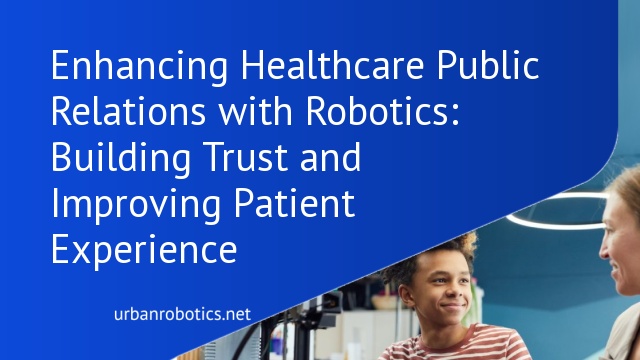Understanding Healthcare Public Relations
Healthcare public relations (PR) focuses on managing and disseminating information between healthcare providers and their various audiences. Effective PR is crucial for building trust and ensuring communities understand the benefits of innovations like robotics in medicine.
Importance of Public Relations in Healthcare
PR plays a vital role in healthcare by shaping public perception and fostering trust. It delivers key messages about medical advancements to patients, stakeholders, and the public. Good PR can highlight the benefits of robotic technologies, making them more accessible and acceptable. Through strategic communication, we can address patient concerns and promote positive narratives.
Challenges in Traditional Healthcare PR
Traditional healthcare PR often faces challenges due to misinformation and rapidly changing medical landscapes. Addressing public concerns can be difficult without timely and accurate communication. Outdated channels and the slow adoption of new media can impede effective outreach. By recognizing these issues, we can adopt innovative methods that enhance our PR efforts, especially important when integrating advanced technologies like robotics.
Role of Robotics in Healthcare
Robotics has made significant strides in healthcare, revolutionizing patient treatment and care. Let’s examine the advancements and benefits these technologies bring to medical procedures.
Advancements in Healthcare Robotics
Surgical robots provide precision that surpasses human capabilities. For instance, the Da Vinci Surgical System enables minimally invasive surgeries with enhanced accuracy. Rehabilitation robots assist in patient recovery by offering consistent, controlled therapy. Diagnostic robots like AI-driven imaging systems detect diseases at early stages, significantly improving patient outcomes.
Benefits of Robotics in Medical Procedures
Robotics in surgery reduces recovery time. Patients experience less pain and fewer complications. Robotic precision ensures consistency and accuracy in procedures, leading to better clinical outcomes. In repetitive tasks like medication dispensing, robots enhance efficiency, lowering the risk of errors.
Integration of Robotics in Healthcare Public Relations
Healthcare public relations can benefit from robotics, offering new ways to connect with patients and convey complex information clearly and effectively. Leveraging robotics enhances communication and increases engagement.
Enhancing Communication Through Robotics
Robotics improve the communication process in healthcare public relations by using interactive robots for patient education and support. Interactive robots like AI-based assistants provide consistent, accurate information, ensuring patients understand complex medical procedures. Robots can be programmed to handle inquiries and provide real-time responses, reducing response time and improving overall patient satisfaction. Visual aids embedded in robotic communication tools help simplify difficult subjects, making them accessible to a broader audience and enhancing overall comprehension.
Case Studies of Successful Integration
Several healthcare institutions have successfully integrated robotics into their public relations strategies, showcasing tangible benefits. For example, Boston Children’s Hospital uses a robot named “Huggable” to comfort and inform young patients, improving their hospital experience significantly. The Mayo Clinic employs robotic kiosks to guide patients and visitors, reducing confusion and enhancing navigational assistance. These case studies demonstrate the practical applications of integrating robotics in healthcare PR and the positive outcomes in patient engagement and operational efficiency.
Impact on Patient Experience
Introducing robotics into healthcare public relations positively impacts the patient experience. Let’s explore how improved patient engagement and addressing concerns with robotics play roles in this transformation.
Improving Patient Engagement
Robotics enhances patient engagement by offering interactive and personalized communication. Robots like Pepper in hospitals guide patients, provide real-time information, and answer inquiries. This direct interaction improves satisfaction and reduces anxiety. Patients can access educational content through robot-assisted platforms, making complex medical information more understandable. Moreover, virtual companionship provided by social robots enhances emotional support, especially valuable in pediatric and geriatric care.
Addressing Patient Concerns with Robotics
Many patients have concerns regarding robotics in healthcare, and addressing these is crucial for trust. Transparent communication through robotic interfaces helps clarify the safety, reliability, and benefits of medical robots. For instance, robots can demonstrate procedures step-by-step, alleviating fears about new technologies. Institutions utilizing feedback from robotic systems to refine practices ensure patient worries are addressed promptly. By demystifying robotics, patients gain confidence in their use and contribute to a smoother technological transition in healthcare services.
Future Outlook
Emerging Trends in Healthcare PR and Robotics
Future outlooks show emerging trends are reshaping healthcare PR. Integration of artificial intelligence (AI) in robotic systems is enhancing patient interactions by offering precise, real-time information. Telepresence robots are becoming popular, facilitating remote consultations and making healthcare more accessible. Social media platforms are increasingly used to disseminate information about robotic healthcare advancements, broadening public awareness and engagement.
Predictions for Future Developments
Predictions highlight significant advancements in healthcare PR and robotics. AI-driven PR strategies will likely become more sophisticated, using data analytics to tailor communication efforts highly effectively. Autonomous robots are expected to handle more complex tasks, aiding in surgeries and elderly care. Personalized robotic assistants will become more common, improving patient satisfaction and healthcare outcomes by offering highly specialized care and support.
Conclusion
Healthcare public relations with robotics is transforming how we communicate and build trust with patients. By leveraging innovative PR strategies and advanced robotic technologies, we can enhance patient experiences and improve overall satisfaction. Transparent communication and the integration of AI are key to addressing patient concerns and demystifying robotics. As we continue to refine our approaches and embrace emerging trends, the future of healthcare PR with robotics looks promising. Our commitment to staying ahead in this dynamic field ensures that we can provide the best possible care and support to our patients.





